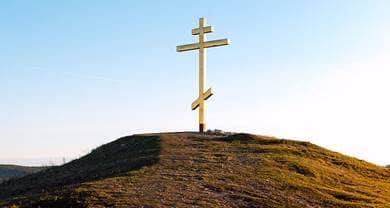- Trending:
- Pope Leo Xiv
- |
- Israel
- |
- Trump
- |
- Social Justice
- |
- Peace
- |
- Love

RELIGION LIBRARY
Eastern Orthodoxy
Beginnings
Christianity is rooted in the life and teachings of Jesus of Nazareth. The story of Jesus and the beginning of Christianity is shared by all Christian groups. Christians were originally united in one church, and participated together in all of the sacraments of the faith, especially the Eucharist, or Lord's Supper. In the first 1000 years or so of Christianity, Christians experienced disagreements and divisions. The unity of the church fractured. Christians, now organized into denominations, no longer practice the sacraments in a common community. This is a cause of grief for many Christians, and there are ongoing efforts to heal the rifts.
Eastern Orthodoxy is a tradition that resulted from these early schisms. It began to emerge in the 5th and 6th centuries of the Common Era, when doctrinal disagreements and geopolitics combined to divide the Byzantine church both from churches in Rome and the West, and from churches in Africa, Syria, Mesopotamia, Armenia, and India. Many of these latter churches, although also Orthodox in faith and practice, are not currently in fellowship with the Eastern Orthodox churches (although this is slowly changing). They are the subject of the articles on Oriental Orthodoxy.
In a slowly-developing rift that unfolded during the 5th to 13th centuries, the principal sees of Rome and Constantinople suffered ongoing disputes that ultimately resulted in a parting of ways, and a loss of fellowship in the sacraments. These disputes are still being addressed in slow and careful dialogue. Historians call the rupture between Rome and Constantinople the "Great Schism," and through it, Eastern Orthodoxy and Roman Catholicism acquired their distinctive identities.
The rift between the two traditions grew so slowly that its exact beginning is difficult to pinpoint. Constantine, the first Christian emperor of Rome, relocated the capital of the empire from Rome to Constantinople (modern-day Istanbul) in 330 C.E. The size and reach of the Roman Empire had persuaded its leaders to experiment with governing from Rome in the west and Constantinople in the east. This move established the prominence of the church in Constantinople, and created the conditions for a rivalry between Constantinople and Rome. A few more centuries passed before that rivalry manifested with any seriousness.
In the 5th century, when the pressures of war and invasion caused the collapse of the Western Roman Empire, the Church in Rome was in many ways the only institutional authority left in western Europe. While western Europe entered a long era of splintered political authority and cultural upheaval, often called the "Dark Ages," the Eastern Roman Empire continued in relative stability for another 1000 years. Because Constantine chose the Greek port town of Byzantium on the Bosporus Strait as the location for the new city of Constantinople, the Eastern Roman Empire became known as the Byzantine Empire. It survived into the 15th century, when it was replaced by the Ottoman Empire. The Roman and Byzantine churches were forged in entirely different historical conditions, meeting entirely different political needs and demands. The Great Schism, which arose from a great variety of reasons—some theological, but many cultural, linguistic, and political—really happened because the two churches grew apart.
The Church in Constantinople enjoyed the protection of an emperor and a military, and flourished in an educated and wealthy city. The Church in Rome responded to the challenges of the "Dark Age" creatively, establishing networks of communication and welfare, and sometimes providing the only source of security and law in western Europe. It responded to the pressures on its survival by building a monarchical form of leadership that invested ultimate authority in the pope. While the Byzantine Church had no objection to this, problems developed between Rome and the eastern Christians when popes began to claim supremacy and jurisdiction over the entire Christian world. The eastern Christians would have none of it because they rejected the idea that decisions affecting all Christians can be made by only one man. In the view of Orthodoxy, only councils attended by bishops from all the churches have authority for all Christians.
Disputes broke out in the 9th century over the Spanish church's addition of the filioque to the Nicene Creed, and again in the 11th century when the Normans began applying military pressure to Byzantine Italy while the pope attempted to enforce Roman jurisdiction over the Byzantine churches. In 1054, the pope sent three delegates to the patriarch of Constantinople in an effort to resolve differences, but neither the delegates nor the patriarch were diplomats in temperament, and they wound up excommunicating each other!
Friendly relations were restored however, and rivalries again receded. In 1071, when the Byzantine Army was defeated by the Seljuk Turks at the Battle of Manzikert, Byzantium turned to its European allies for help. Pope Urban II raised an army, and the Crusades began. The Crusaders successfully returned much of conquered Byzantine territory to Constantinople, but also established kingdoms of their own in Syria and Palestine. This brought the disputes between Rome and Constantinople to the grassroots, as the Crusaders imposed Latin practices in these traditionally Greek churches. Arguments over who had the right to appoint bishops led in some places to rival bishops, Greek and Latin, claiming the same throne.
The Crusades eventually led to the cataclysmic invasion and pillage of Constantinople by a Crusader army in 1204. The three-day merciless plunder of this famous Christian city by soldiers with crosses on their shoulders left the Byzantines deeply embittered, if not hateful. Since this time, the two churches have been alienated from each other, each claiming to be the true Church. The sides have recently taken fresh steps, in hopes that in time a reunion could be accomplished, in careful and deliberative ways.
Study Questions:
1. How was Christianity united with a common origin? When did Eastern Orthodoxy begin to originate?
2. What was the Great Schism? How was Christianity divided?
3. How did the two churches respond to the Dark Ages?
4. What developments in doctrine or practice contributed to the separation of Orthodox from Catholics?










